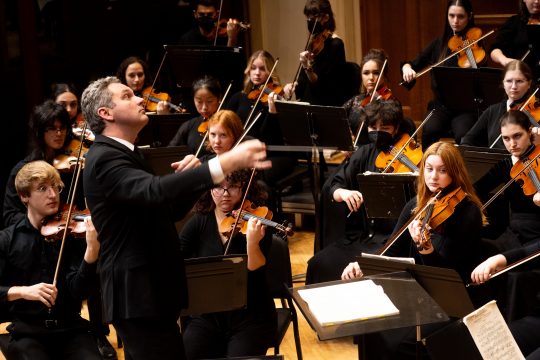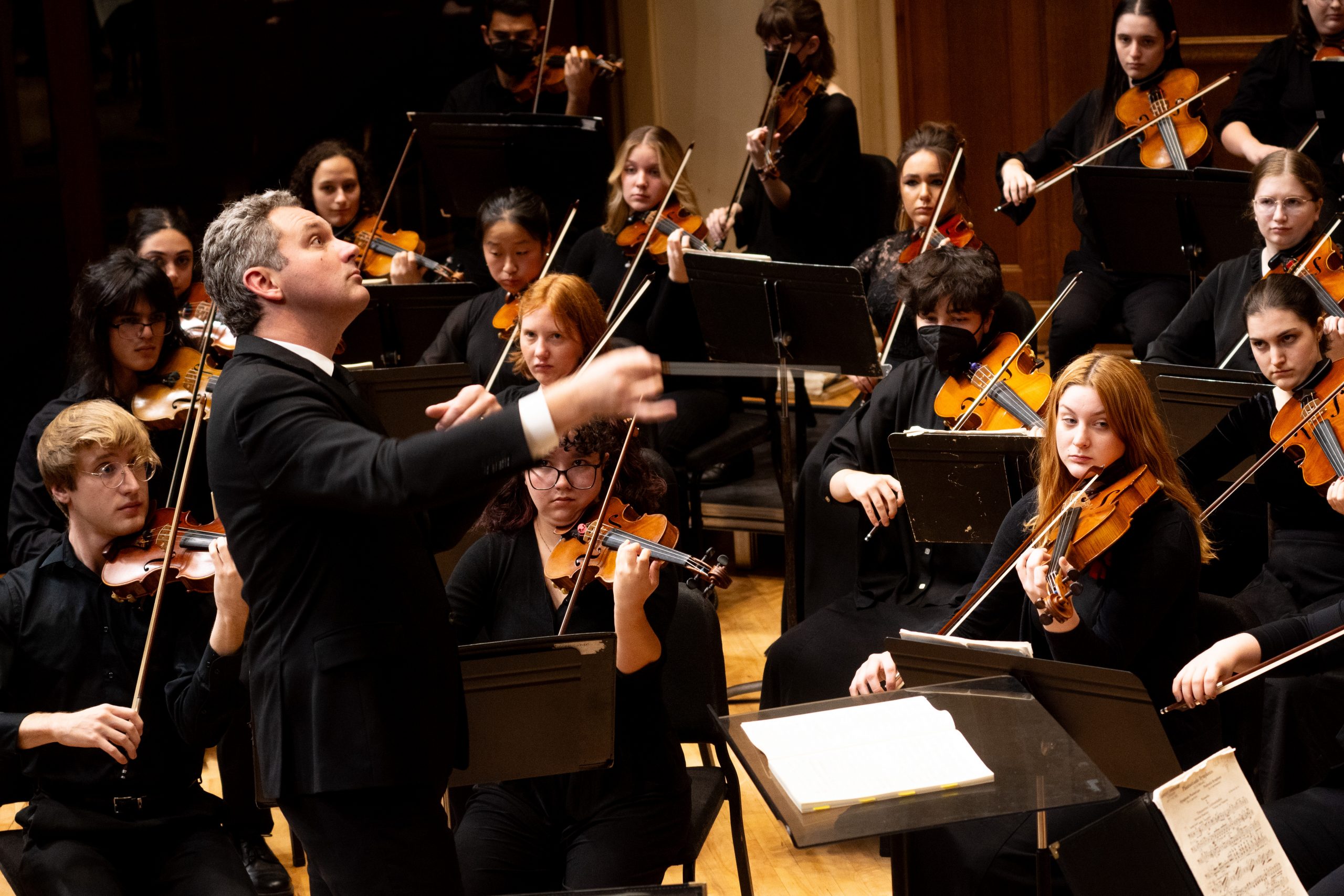The Lawrence Symphony Orchestra (LSO) featured only a single work in their concert this past Saturday, Oct. 7. But this was no ordinary composition — it was Hector Berlioz’s monumental “Symphonie fantastique.” Written in 1830 in the midst of French Romanticism, the symphony treads the entire range of human emotions, complete with gentle melodies and bombastic marches.
“[It’s] probably the best-known piece of Berlioz’s music,” said Associate Professor of Music and Director of Orchestral Studies Mark Dupere, LSO’s conductor. Dupere told a story of a concert where one of the composer’s less renowned pieces was stopped mid-performance as the audience demanded he conduct “Symphonie fantastique” instead.
The delicate opening was masterfully approached by the strings and woodwinds. However, cohesive tuning soon fell apart during the quicker violin lines. Although the woodwinds quickly restored balance, they too succumbed to their own tuning mishap during an exposed chord. Thankfully, Dupere kept the momentum going regardless.
During a quieter section, five successive horn motifs helped the ensemble get back on track. They were played with a much-needed gentle confidence by senior Connor Parr and sophomore Lauren Coon. Unfortunately, tuning issues remained throughout, although lesser than before. This is at least understandable: the easiest way for ensembles to tune is in full textures with prominent low notes — a scenario often absent in this movement.
The orchestra seemed somewhat more grounded in the second movement, although the chosen tempo was certainly too slow. As a lively waltz, the constant bass note emphasis assisted in tuning, but the issues were not erased. The duet between flutist Darren Lam and clarinetist Isabelle Olsen was a particularly moving highlight. When Olsen returned with a solo later, any perceptive listener would have wished it didn’t have to end.
Many “Symphonie fantastique” enthusiasts pretend that the work’s third movement does not exist. It’s not poor music, per se, but its excruciatingly slow pace contrasts greatly with the other movements. It can be soothing and meditative when done correctly, and LSO hit it on the spot. This was helped tremendously by the excellent English horn-oboe duet from Sherilyn Patterson and Jack Thompson, respectively.

The fourth movement was a breath of fresh air. There was a resounding certainty introduced by the percussion section — they fully balanced any hesitancy from before. Everyone stepped up their game; the strings’ pizzicato was together and the unison bassoon quartet from Iris Hakes, Colin Hutton, Tara Maycroft and Kai Outzen was impressively in sync.
Third-year transfer student Wren Whalen’s E-flat clarinet stole the show of the final movement’s opening. They impressively captured both the section’s creepy and playful qualities with impeccable tone quality. The brass section must be applauded as well. The trombonists — William Gear, Leah Kukman, Ryan Saladin — and the tubists — Hannah Anderson and Chance Arnold — clearly put extensive consideration into their featured sections. As a result, the low brass delivered a powerfully resonant and impressive sound, which drove the piece through its triumphant finale.
“To understand this kind of work,” explained Dupere, “there’s two narratives we should talk about. A work of love and lust — both violent and pleasurable — the symphony relates equally to both Berlioz’s personal life and storytelling vision.”
When a young Berlioz first saw the Shakespearean actress Harriet Smithson perform, he was transfixed, according to the traditional narrative. More accurately, he was obsessed with her and concocted numerous methods of getting acquainted with her (she refused to meet him).
For Berlioz, she became synonymous with the Shakespearean heroine of her repertoire, and this delusional transfiguration spurred the immense creativity which is “Symphonie fantastique.” Smithson was reportedly impressed and flattered by the piece, and the two had a 10-year marriage which gradually deteriorated.
Such sentiments were not the official rationale for Berlioz’s work. Instead, the composer wrote a lengthy program note, which he requested be forever reprinted at any performance of the piece.
Berlioz was aiming to craft a fully programmatic instrumental work — that is, one which intentionally tells a story. Although not the first of its kind — one may think of Vivaldi’s “Four Seasons,” or Beethoven’s ” Pastoral” Symphony No. 6 — earlier examples often focused on general moods rather than a specific narrative.
The intended program of his work follows a tortured artist and his love of an elusive woman (sound familiar?). Although the first three movements depict seemingly normal love scenes, they quickly descend into madness. The narrator now has a dream in which he kills his beloved. He is now paraded through the streets towards his execution in the fourth movement.
The fifth movement’s program is not entirely clear. It seems to be a post-death defeat sequence, complete with hallucinatory visions, witches, wizards and dances. In any case, with Halloween right around the corner, it was certainly a well-timed concert!

